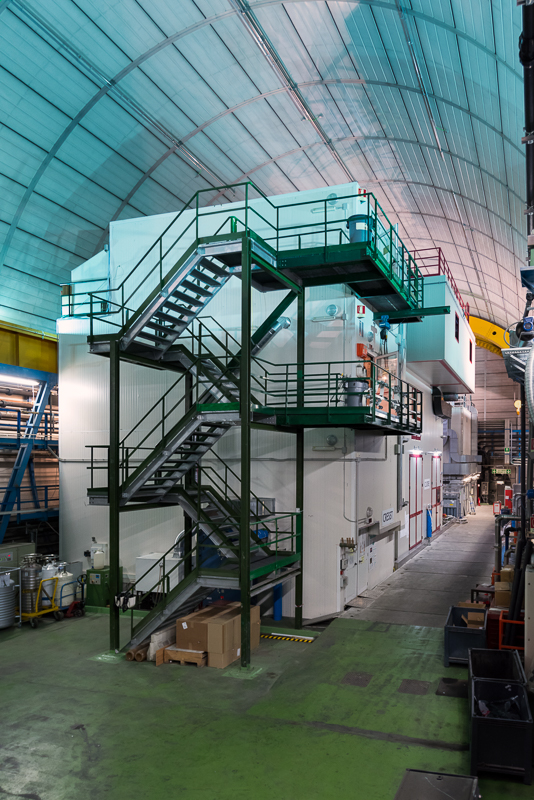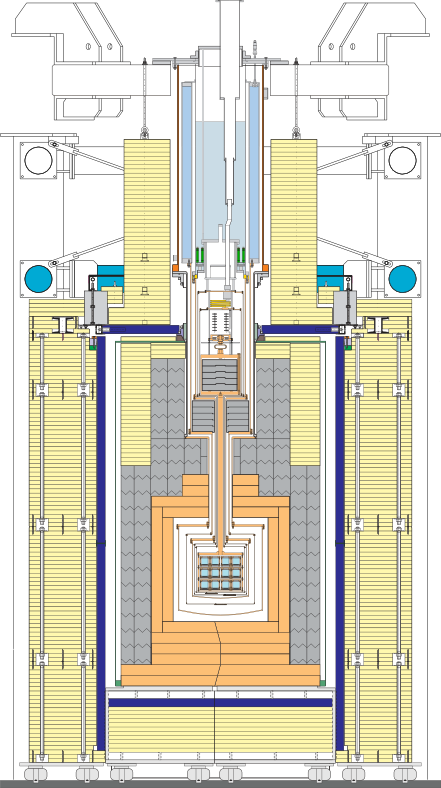The LNGS is the home to several experiments searching for rare events in particle physics such as dark matter or neutrino interactions. The three experimental halls are covered by at least 1400m of rock which reduces the flux of cosmic radiation by 1 million compared to above ground.
A three level building houses the entire CRESST setup. The ground floor is equipped as a clean room to provide clean conditions for mounting the detectors. The second floor allows access to the top of the cryostat and the electronics for regular maintenance. On the top floor, there are facilities to prepare the detectors before mounting.
Since CRESST employs cryogenic detectors, the central part of the setup is a dilution refrigerator that cools the detectors to their operating temperature of around 15mK. The experimental volume housing the detectors is surrounded by a series of copper vessels which are cooled to intermediate temperatures between 15mK and room temperature. In between these vessels, there is a vacuum to provide thermal insulation. To reduce vibrations, which can disturb the detectors, the cryostat is resting on air dampers and the actual experimental volume is suspended from a spring-loaded support structure.
Due to the low event rate anticipated for dark matter particle-nucleus elastic scattering, an extremely low background environment is required.
We expect only very few dark matter interactions to happen in our detectors per year. However, not only dark matter particles but also other particles like muons, neutrons, electrons, photons and alpha particles will interact in the detectors. These can come from cosmic rays, as well as from natural and induced radioactivity near the detector. These background signals, if not suppressed, would occur much more frequently than the signals expected from dark matter particles. Therefore, special care has to be taken in selecting materials with very low amounts of radioactive contaminations to construct the detectors and the surroundings.

The CRESST experiment in the Gran Sasso underground laboratory
(Photo: A. Eckert/MPP)
To suppress events caused by ambient radioactivity as much as possible the detectors are surrounded by multiple layers of passive shielding. From the outside to the inside these are:
- 45cm of polyethylene
- 20cm of lead from a Swedish underground mine, which has a low amount of radioactive contaminations
- 15cm of copper, which can be produced very purely
The polyethylene reduces the flux and the energy of ambient neutrons while lead and copper shield against beta and gamma radiation. Because lead itself has a relatively high amount of radioactive contamination, the inner shielding is made from copper, which is less contaminated.
In addition to these passive components, there are two active systems to prevent and identify potential background signals. The first is an air-tight box, which is constantly flushed with nitrogen gas to prevent the accumulation of radioactive radon gas and its decay products near the detectors. The second is the so-called muon veto, which surrounds the entire setup and detects the few remaining muons from the cosmic radiation passing through the mountain close to the detectors. Since these muons can produce secondary particles mimicking a dark matter signal, it is important to know when a muon came close to the detectors, so all signals that appear at the same time can be excluded from the analysis.

